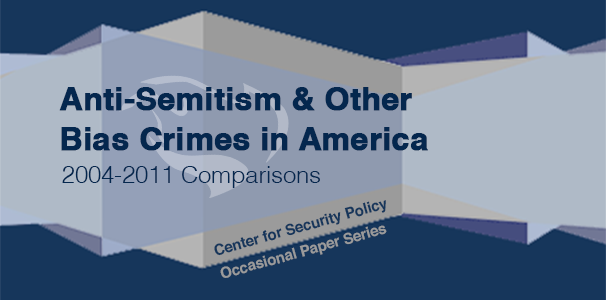Anti-semitism in America: 2004-2011
As the Million Muslim March is scheduled for 9/11/2013, the Center for Security Policy has released a comprehensive study titled, “Anti-Semitism and Other Bias Crimes in America: 2004-2011 Comparisons.” The premise of the march is that Muslims are being discriminated against. That is addressed in this study, with the FBI data on hate crimes painting a much different picture.
The Center created an online database, with over 17,365 reports for localities showing hate crimes from 2004-2011, as well as 44 reports for US nationwide reports and 5 comprehensive nationwide reports for each broad category of victim groups (bias groups), also from 2004-2011. Read the full report here.
The CSP website states, “In its March 2011 Occasional Paper entitled, “Religious Bias Crimes 2000-2009: Muslim, Jewish and Christian Victims – Debunking the Myth of a Growing Trend in Muslim Victimization,” the Center for Security Policy (CSP) used official annual data published by the Federal Bureau of Investigation (FBI) to debunk the common fallacy spread by “Islamophobia” proponents that Muslims have been the target of an increasing wave of “hate crimes” in the years following the attacks of 11 September 2001. In fact, as the FBI data show, the number of religious bias crimes (or “hate crimes”) against Muslims post-9/11 is actually significantly lower than such crimes against Jews.”
From 2000 through 2009, the Center found that, according to the FBI statistics, Jewish victims of hate crimes outnumbered Muslim victims by about six to one.
Subsequent FBI statistics for 2010 and 2011 show a ratio of Jewish to Muslim victims of about five to one. The study’s presentation of hard data on such “religious bias crimes” (only reinforced by the additional data from the two more recent years) exposed the political agenda of certain highly vocal Muslim lobbying groups, many linked to the Muslim Brotherhood and leftwing activists, which persist in promoting the false narrative of America’s alleged “Islamophobia.” In fact, there is no “rising trend” in hate crimes against Muslim Americans and allegations to the contrary are demonstrably counterfactual as well as “corrosive to community relationships at every level of American society, and a potential threat to national security,” as Center for Security Policy President Frank Gaffney pointed out.
With that 2011 study as a baseline, the Center for Security Policy expanded the earlier analysis for a second phase of analysis.
Methodology
This second phase of the study has two components:
First, the Center created an online database, with over 17,365 reports for localities showing hate crimes from 2004-2011, as well as 44 reports for US nationwide reports and 5 comprehensive nationwide reports for each broad category of victim groups (bias groups), also from 2004-2011. The Center has put this database into the public domain in order to provide longitudinal data showing trends to all groups representing historical or potential victim categories, as well as to all localities from the federal to state to city or even university reporting agency level. Only when the public can see the actual data – and trends – in hate crimes for a significant period of time, in this case from 2004-2011, can they assess the seriousness of the problem and the context to develop policies, if needed, to address it. The categories of reports in the online database include:
- 44 Comprehensive Reports: US nationwide data from 2004 – 2011 for incidents, offenses, victims, and known offenders;
- 5 Comprehensive Reports: US nationwide data for individual bias victim groups, across all types of offenses, from 2004-2011;
- 17,365 Summary Reports: Locality information for all states, cities, universities, county law enforcement agencies, tribal law enforcement agencies and other entities such as railroads that report hate crimes using the Uniform Crime Reporting protocol to the FBI, from 2004-2011, compared in each local report two other tables: the state’s total for bias categories and agency types. These localities’ data are provided by the FBI at a summary level (religion, race), not at the detailed level of bias crimes against specific religions (anti-Jewish, anti-Catholic) or specific races (anti-Black, anti-White).
The second component of this analysis is provided in this report, with a selection of graphs showing the findings presented in the online database. All comparisons were based on the data provided by the FBI Uniform Crime Reporting data for hate crimes from 2004-2011.



Trackbacks & Pingbacks
[…] […]
Comments are closed.